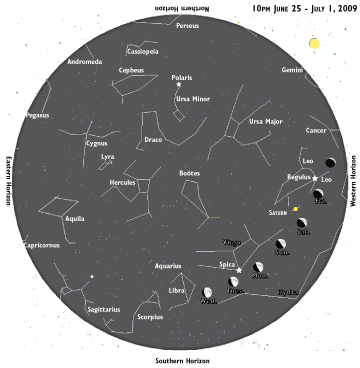
Volume XVII, Issue 26 # June 25 - July 1, 2009 |
 |
 |
Sky Watch
by J. Alex Knoll
Round the Bend
We’re slowing down as earth passes its farthest from the sun
A waxing crescent moon arcs through our afternoon and evening skies at week’s end, showing its face even in daylight. As darkness settles Thursday, the moon in the west forms a line with the first-magnitude star Regulus and even brighter Saturn. Friday the moon trails Regulus, and with Venus the three now form a loose triangle. Come Saturday, the near-first-quarter moon is just a few degrees below Saturn.
With the new week the now-gibbous moon accompanies Spica, the first-magnitude blue-white star of Virgo. Spica is 10 degrees to the moon’s east on Monday, and six degrees to the north of the moon Tuesday.
Saturday marks the latest sunset of the year, when Old Sol dips beneath the horizon at 8:35. Since solstice last week, the length of each day has waned, but thanks to earth’s 231⁄2-degree tilted axis and its elliptical egg-shaped orbit around the sun, a couple weeks separate the earliest sunrise from the latest sunset.
Earth next week will be 94.8 million miles from the sun, the farthest in its annual orbit. The difference between aphelion and perihelion — the closest — is only 3.1 million miles, or less than four percent. But a few million miles amount to a weaker gravitational pull from the sun, slowing our planet as it lazily rounds the bend in its outer orbit. This difference in earth’s speed is why summer is the longest season of the year, a full day longer than winter.
As daybreak approaches, around 5:45 this week, you’ll find tallow-colored Jupiter high overhead, brighter than any star. Only one light, other than the moon, shines brighter than Jupiter, and you’ll find Venus low in the east-northeast with much dimmer Mars a little higher in the sky.
Illustration: © Copyright 1925 M.C. Escher/Cordon Art-Baarn-Holland; Graphics: © Copyright 2009 Pacific Publishers. Reprinted by permission from the Tidelog graphic almanac. Bound copies of the annual Tidelog for Chesapeake Bay are $14.95 ppd. from Pacific Publishers, Box 480, Bolinas, CA 94924. Phone 415-868-2909. Weather affects tides. This information is believed to be reliable but no guarantee of accuracy is made by Bay Weekly or Pacific Publishers. The actual layout of Tidelog differs from that used in Bay Weekly. Tidelog graphics are repositioned to reflect Bay Weekly’s distribution cycle.Tides are based on National Oceanic and Atmospheric Administration and are positioned to coincide with high and low tides of Tidelog.
